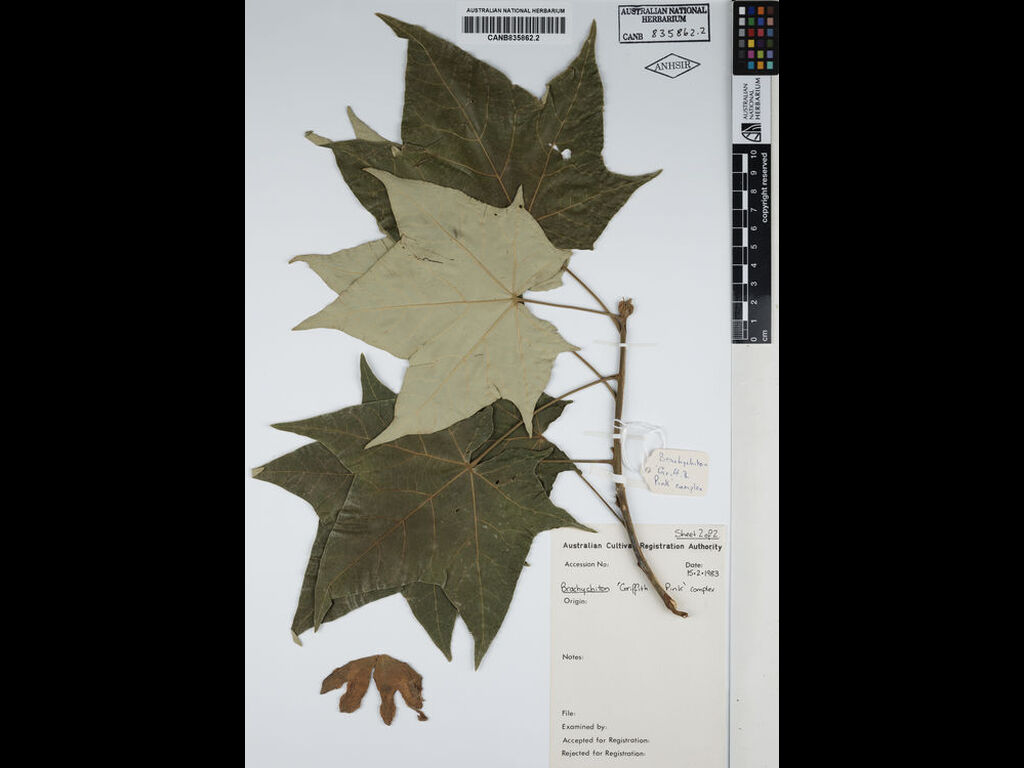Brachychiton 'Griffith Pink'
- File Number
- 268
- ACRA Field Book Number
- -
- Registration Date
- 27/10/1986
- Application Received
- 01/01/1981
- Family
- Malvaceae
- Cultivar Name
- Brachychiton 'Griffith Pink'
- Origin
- Brachychiton 'Griffith Pink' is a hybrid between B. discolour and B. populneus. The applicant believes that this cultivar originated in the Murrumbidgee Irrigation Area. The actual place of origin of this cultivar will remain obscure as checking with herbaria in Queensland and NSW revealed a collection at Condong, NSW (near Tweed River) on alluvial flats. Dr G Guymer of the Queensland Herbarium has located a naturally occurring hybrid at Boonah in 1985, though to his knowledge no other collection of such a hybrid had been made prior to this time. Cultivated collections of this hybrid have been recorded from Deniliquin (1914), Tumut and the Royal Botanic Gardens in Sydney. The cultivar was first received by the Authority in January 1981. Registration applied for by MR J W Pyle, New Era Nursery, Wahgunyah, Victoria 3687.
- Characteristics
- This cultivar will grow from 9 to 10m tall. The mature leaves have prominent lobes and are maple like in shape. Mature leaves are up to 12cm broad at their widest point and are distinctly veined. The flowers, found from approximately November to March, are pink in colour and very conspicuous. They are slightly hairy, with the hairs being a light rusty brown colour. The underside of the calyx is mottled with white. Diagnosis: Brachychiton 'Griffith Pink' differs from Brachychiton 'Jerilderie Red', a similar cultivar in that the flowers are larger and a deeper colour and the leaves are lobed. The leaves of Brachychiton 'Griffith Pink' are smaller than B. discolour.
- Cultivation
- Vegetative propagation must be used to preserve the cultivar form. This cultivar has been successfully grafted on to B. populneus by the applicant. Cultivation requirements are similar to those required by B. populneus.
- Publication
- Payne, W.H. (1989), Garden Cultivars of Australian Plants. Australian Plants 15(121): 202; Hort Journal Australia Sep 2921 Vol 14, Issue 3, Page 40
- Colour Coding
- RHS Colour Code 1966.calyx: close to red group 53C. The calyx is slightly hairy withbrownish colour. The underside of the calyx is mottled with white.
- Propagation
- Cuttings from semi-firm new growth
- Applicant Name
- MR J W Pyle
- Uses
- Feature tree
- Availability
- Specialist native plant nurseries
- ANBG Accession Numbers
- ACC268; CBG8100029.G. Butler 1064
- NSL ID
- -
.dig_31240.jpg)
